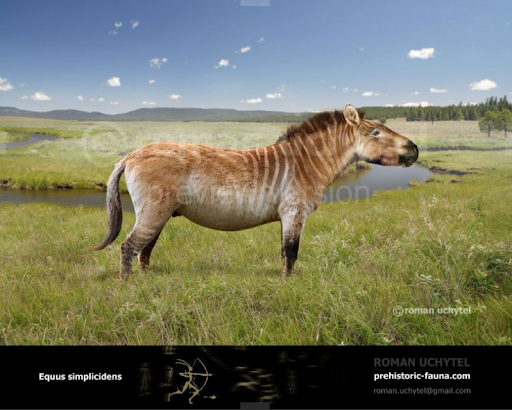Welcome to American zebra (Equus simplicidens)

Name Definition
Simple horse
Name Given By
Edward Drinker Cope in 1892
Location
Hagerman, Idaho as well as Texas of the United States
Classification
Mammalia, Ungulata, Perissodactyla, Hippomorpha, Equidae
Size
approximately 1.7 meters tall (5.5 ft), around 2.6 meters long (8.5 ft)
Temporal Range
Middle Pliocene - Pleistocene, about 3.5 - 2.58 million years ago
Ecological niche
small grazing herbivore compared to the other herbivores living at the time
Species/Sub Species
Unavailable
Diet
like many other horses, the Hagerman horse would have followed a spot grazing lifestyle, where a herbivore may eat one patch of grass bare to the ground but leave other patches untouched, though the Hagerman horse may have consumed foliage like a browser to supplement its diet
Introduction
Equus simplicidens is a species of extinct equid horse from Idaho and Texas and lived during the Pliocene to the Pleistocene. Equus is Latin for “horse” since Equus is a horse genus, and simplicidens means “simple” since the American zebra is considered the oldest known horse in the fossil record, so of course it would be relatively basal and simple compared to its descendants.
The American zebra was originally discovered in Idaho in 1928 by rancher Elmer Cook. In 1930, Smithsonian paleontologist James W. Gidley (he also led the excavations of Hagerman in that same year) gave the specimen discovered in Idaho the name Plesippus shoshonensis. However, further examination of the fossils showed that they closely resembled another horse discovered in Texas called Equus simplicidens which was named by Edward Cope in 1892. Plesippus was then considered to be synonymous with Equus simplicidens due to the similarity, and since Equus simplicidens was named earlier, Equus simplicidens was the name given to this specimen according to the Principle of Priority. The fossils of the Hagerman Equus simplicidens represent some of the earliest remains ever in the Equus genus, which gave it the specific name simplicidens.
When Elmer Cook discovered the remains, he took them to Dr. Stearns of the U.S. Geological Survey who then provided them to Gidley at the Smithsonian Institution. The bones were identified as belonging to a prehistoric horse, and so the location where it was discovered in Hagerman is now called the Hagerman Horse Quarry, named after Equus simplicidens or the Hagerman horse. There were 3 more tons of excavated specimens from the Hagerman Horse Quarry that were also sent back to the Smithsonian Institution in Washington, D.C.
Excavation of the Hagerman Horse Quarry continued in the 1930s. The Hagerman Horse Quarry floor grew to be around 5,000 ft² (460 m²). There were 5 virtually complete skeletons, more than 100 skulls, and 48 lower jaws and a large number of other isolated bones that were discovered. Due to the numerous bones that have been found in the quarry, paleontologists believe that the Hagerman Horse Quarry was, at one point, a watering hole. This watering hole could have been the area where Hagerman horses in poor health would be drawn to water and then die there. However, this does not explain why only one horse species would be drawn here as watering holes are known to be a water source for a wide variety of animals in an ecosystem, so other paleontologists think that an entire herd of Hagerman horses drowned in an attempt to cross a flooded river and drowned while being swept away by the river where it would eventually end up being buried in the soft sand at the bottom.
The Hagerman horse would have first appeared around 3.5 million years ago in Hagerman, Idaho as one of the first species of Equus horse. Equus simplicidens was around 1.4 meters tall at the shoulder and around 110 - 385 kg. The average Hagerman horse would have been around the size of the Arabian horse. It was also relatively stocky with a straight shoulder and a thick neck like modern-day zebras, as well as short, narrow, and donkey-like head. These are not the only features the Hagerman horse shares with zebras, but in real life, the Hagerman horse is speculated to have resembled Grevy’s zebra (Equus grevyi) with some black stripes running down its neck, back, and hind quarters. This gave Equus simplicidens the name “American zebra” since it is speculated to look like a zebra and was found in Idaho.
Equus simplicidens most likely lived in grasslands and floodplains which is what Hagerman was probably like during the Pliocene. Most wild horses native to North America became extinct around 10,000 years ago, which is the same as when many of the other large mammals of the Cenozoic went extinct. While it hasn’t been discovered anywhere else, it isn’t implausible that the Hagerman horse lived across most of North America, as it was suited to the dry grasslands that were the most abundant habitats across North America during the Pliocene epoch.